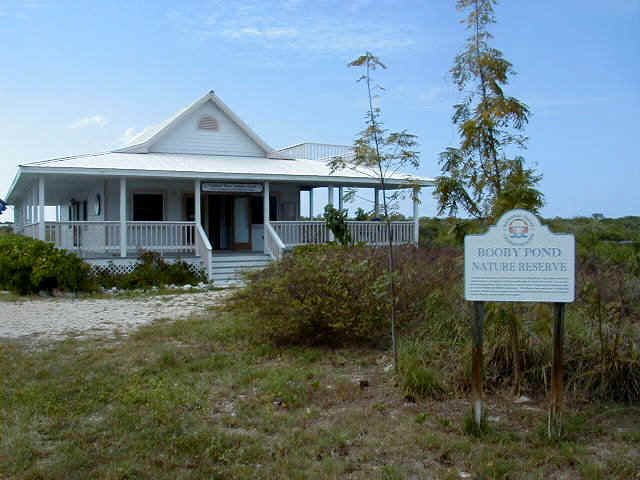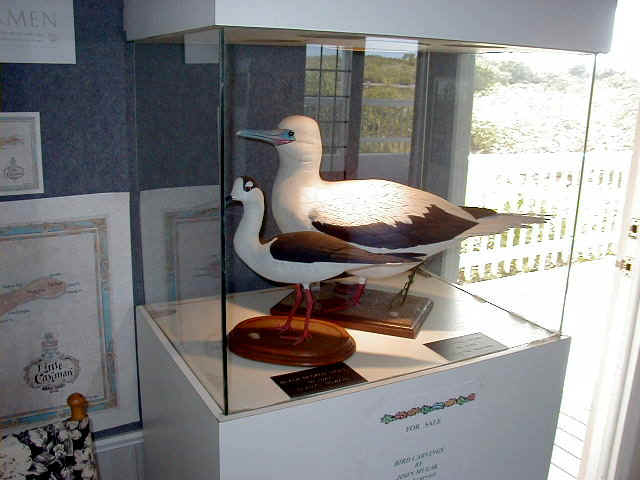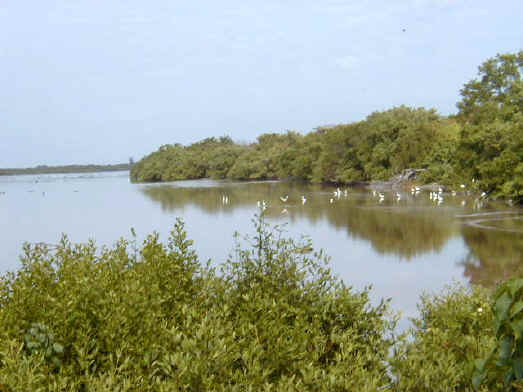
The National Trust of Little Cayman
"The mission of the National Trust for the Cayman Islands is to preserve natural environments and places of historic significance for present and future generations of the Cayman Islands."

Pictured above is the Trust House, by the Booby Pond Nature Preserve. This building was built entirely with volunteer labor--people on the island pitching in to create a community center for the island. Groundbreaking was in 1995, and I remember that back then you couldn't walk past this place without somebody reaching out and grabbing you and trying to stick either a hammer or a paint brush into your hand. I do feel guilty now...I didn't contribute back then, and I should have. I now realize what a valuable contribution to our island the National Trust has made and continues to make, and today I'm trying to do what I can to help put something back into this place I love so much.
In 1995, the Crown transferred 135 acres in the Booby Pond and Rookery to the National Trust. The Booby Pond itself, and the western 1/3 of the Booby nesting colony, thus became a nature preserve under the ownership of the National Trust. Residents on the island all pitched in and built this building, which contains a multitude of exhibits to explain the ecology of the Booby Pond together with several viewing platforms and telescopes. And the island residents then began fund raising--in earnest. You couldn't walk down the street in Little Cayman without being asked to contribute in some way or another to the National Trust. There have been periodic celebratory dinners each year at various resorts, with food donated by the resort and all proceeds going to the National Trust. Rummage sales...bake sales...you name it! And the biggest event of all has been the annual Easter auction, year after year. EVERYBODY contributes something, and then on the Saturday before Easter the auctioneer holds forth. It might as well be Sotheby's...and the prices are just about as high. The Trust did raise the money, and in May of 2000 the National Trust purchased an additional 64 acres, thus giving the Trust ownership of the entire Booby nesting area.
| Here is Peter Hildebrand, the owner of Southern Cross Club, making his debut as auctioneer during the Easter 2002 Trust Auction. Peter did an excellent job of coaxing out the highest bids possible, which is another way of saying I didn't end up buying anything. This particular item is a framed and matted water color of Gladdys Howard's (i.e., Pirate Point's) new dock. Gladdys was standing right beside me when I took this picture, and as you can see Peter was determined to make her pay dearly to win that painting. She did win it, of course, and the painting is now hanging in Gladdys' new home at Pirate's Point. |
|
|
Little Cayman is home to the largest colony of
Red-Footed Boobies in the western hemisphere. A recent survey estimated the size of
the colony at 20,000. In addition, the Booby Pond is home to the Cayman Island's
only breeding colony of Magnificent Frigatebirds. We have two telescopes on the back
porch of the Trust House with which to watch the wildlife. Once you know where to
look, and understand what is happening, there's a fascinating drama unfolding in the
nesting area on the far side of the pond. You can't make it out in this picture, but the trees on the far side of the pond are packed with Booby nests right now. The breeding season for the Booby runs from November-April. There is an elaborate courtship ritual in the fall, and then the Boobies pair off. The female lays exactly one egg in a nest of rough sticks, and thereafter the hatchling is always guarded by one of the two parents. The chicks stay in the nest for 14-16 weeks after hatching, and fledge the nest by mid-April. These are not small birds, by the way. An adult Booby weighs, on average, 2.2 pounds. I would estimate the wingspan at about 48". This picture was taken in late February, and at this point the "hatchlings" are quite large indeed. I have spotted dozens of nests through this telescope, each one with an adult standing guard just a few feet away. The chicks are all fluffy white, with a black mask on their faces, and getting quite fat by now. It's hard to believe chicks this large still are unable to fend for themselves, but that's the way it works. One of the parents will go up to 40 miles out to sea in search of squid and other delicacies to bring back to Baby Huey. The foraging parent can be gone up to 4 or 5 days on this search; meanwhile, the other parent stands guard over the nest. |

This is a woodcarving of a white morph Booby. Roughly 90% of the Boobies are brown, but the other 10% do look just like this one. I have located one nest in the pond which belongs to a pair of whites, but as luck would have it there is a post blocking the view from the telescope to that nest.

The Booby Pond also plays host to a number of species besides the Red-Footed Booby. Here is a flock of Snowy Egrets, bobbing for dinner in the shallows. There are also West Indian Whistling Ducks, plus lots of migratory waterfowl from the US. Large numbers of Mallards, Blue-Wing Teal, and Green-Wing Teal make it down here for the winter. There are also bunches of Coot, which I would just as soon not see, but the most thrilling (to me) duck of all is the Wood Duck. I've seen bunches of Woodies on Little Cayman, and these things are getting to be very rare back in the US.
By far the most interesting inhabitant of the Booby Pond is the Magnificent Frigatebird, also called the Man-of-War. These things are huge--the wingspan must be 60" or more. They have the most efficient airfoil in their wings of any bird I have ever seen. They can soar for hours without ever seeming to move a muscle, and when the winds are strongest they seem to be able to remain absolutely stationary along the coast without even twitching. Yet when the occasion demands it, the Frigatebirds can become aerial acrobats. In the late afternoon, they line the coast and await the return of the Boobies from their search far out at sea to obtain food for their nestlings. When the Boobies come back at night loaded with dinner for Baby Huey back home in the nest, the Frigatebirds are there waiting for them. The Frigatebirds are incredibly fast and agile as they chase the returning Boobies, and sometimes the show in the sky looks just like Snoopy vs. the Red Baron. Eventually the harried Booby decides the only way to get away from the pursuing Frigatebird is to lighten its load and upchuck the dinner it was bringing home for Baby Huey, and at this point the Frigatebird makes a mad dash to grab the Booby barf before it hits the water. This is a performance that is played out multiple times each evening during late winter and early spring as the Boobies struggle to feed their growing and ravenous hatchlings.
| This is my "desk" inside the Trust House for one afternoon each week when I assume the role of island naturalist to explain the ecology of the Booby pond to visiting tourists. It's a sometimes boring role, when nobody comes by, but occasionally I get the opportunity of arousing genuine excitement as I show visitors how to spot the Booby nestlings and explain their life cycle. |
|